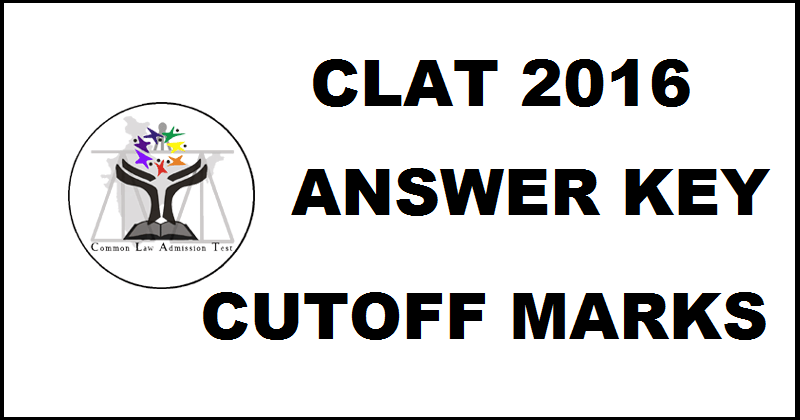
CLAT 2016 Answer Key Question Paper With Correct Responses Exam Analysis Available Now
Rajiv Gandhi National University of Law, Punjab successfully conducted Common Law Admission Test (CLAT) 2016 for UG & PG courses on 8th May 2016 from 3 PM to 5 PM. A large number of candidates applied and appeared for the examination. Candidates who had written the exam can check the answer key with cutoff marks from the direct link provided below. By checking the solutions candidates can analyse the performance in the examination.
CLAT Answer Key/ Cutoff Marks 2016:
Common Law Admission Test (CLAT) is a centralised test for admission to 17 prominent National Law Universities in India. The test is taken after the Higher Secondary Examination or the 12th grade for admission to integrated under graduation programmes in Law and after Graduation in Law for Master of Laws(LL.M) programmes conducted by these law universities. CLAT exam is conducted for Integrated Degree Course like BA-LLB, B.Com-LLB, B.Sc-LLB & Other Approved Coursed by Bar Council of India. Every year CLAT examination is conducted by one of the National Law Universities.

This year the Rajiv Gandhi National University of Law conducted CLAT 2016 examination and the candidates who had written the exam can check the answer key/ cutoff marks 2016 from the official website.
CLAT 2016 Answer Key:
Rajiv Gandhi National University of Law, Punjab released notification and invited online applications for the CLAT 2016 examination. All the eligible and interested candidates applied and appeared for the examination. The exam is for 200 marks and there is a negative mark of 0.25 for each wrong answer. Aspirants can check the unofficial CLAT 2016 answer key which is solved by various private coaching institutions.
Name of the University: Rajiv Gandhi National University of Law, Punjab
Name of the Exam: Common Law Admission Test
Date of the Exam: 8th May 2016
Category: Answer Key
CLAT 2016 exam Analysis:
The test was of easy to moderate difficulty level. Among the 5 sections, Elementary Mathematics or the Numerical Ability section had the lowest weightage but it had tricky questions which, consumed substantial amount of test time.
General Knowledge: The difficulty level was easy to moderate. 90% questions mostly followed the mainstream current affairs news only.
Elementary Mathematics: This was probably the section that has changed the most in terms of the level of difficulty. This section of the paper had 20 questions.There were a few questions that were “tricky”, which could have tempted the students in marking the wrong answers.
English with Comprehension: This section had 1 Reading Comprehension passage and the rest of the questions were on English Usage. The topics of the questions were Grammar (Proposition, Verb, Adjective, Adverb), Fill in the blanks, Idioms & Phrases, and Spellings.
Legal Aptitude: There were 15 Questions of Legal Knowledge which were fairly easy. The rest were Legal Reasoning which did not have any “surprise” elements. There was absolutely no need for any prior legal knowledge to crack this section. Most of the questions had 2 choices which were definitely not the answers !! There was a good mix of Torts, Contracts, …and other types of Law questions.
CLAT 2016 Cutoff Marks:
The cutoff marks for CLAT 2016 depend on the total number of candidates appeared for the examination, the difficulty of the paper etc. Moreover, the cutoff marks are different for different colleges. We will update exact CLAT 2016 Cutoff Marks here for General, OBC, ST and SC.
According to the experts, the top participating colleges’ cutoff would be above 140. The cutoff for the top 3 colleges would be from 140 to 145.
Check CLAT 2016 Question Paper with correct responses here:
Candidates can see the Question Paper with correct responses and their own responses here. The email id and password of the individual candidate remain the same which was used for downloading the Admit Card.
Upload CLAT 2016 responses here:
Candidate can upload their responses, if any (upto 15th May, 2016) with evidence by clicking here. The user ID is the application number of the candidate and the password is the date of birth.